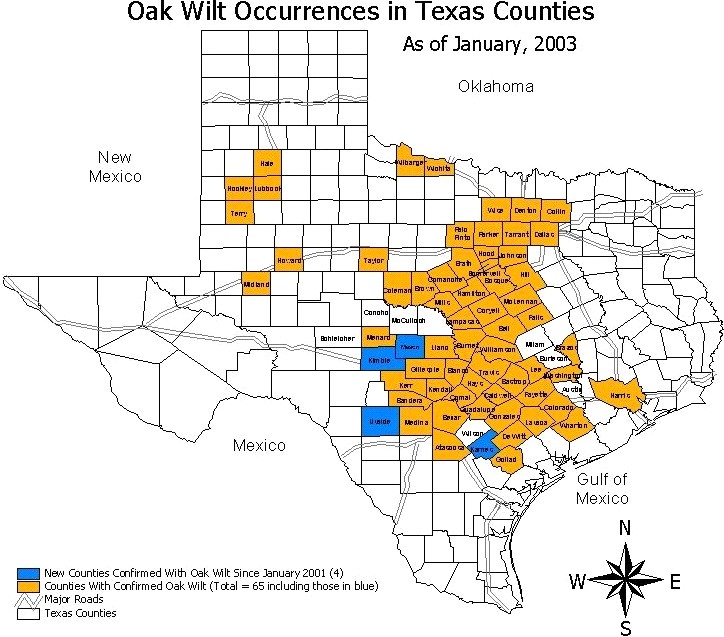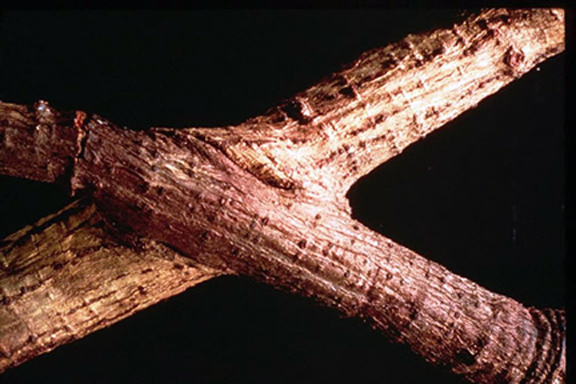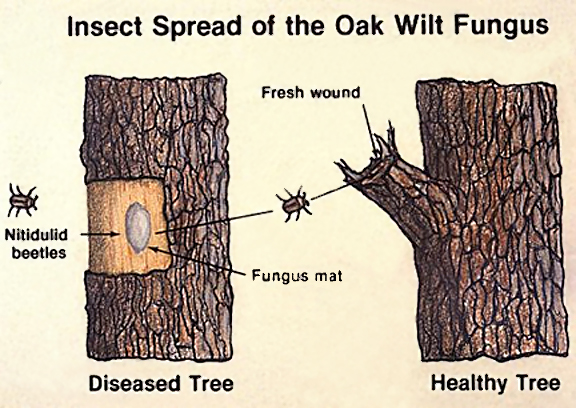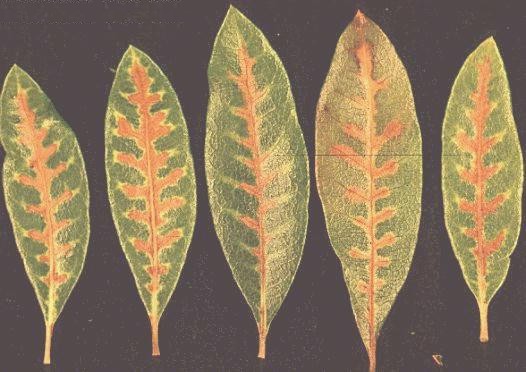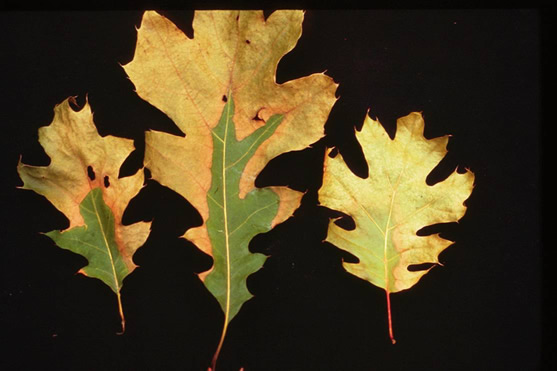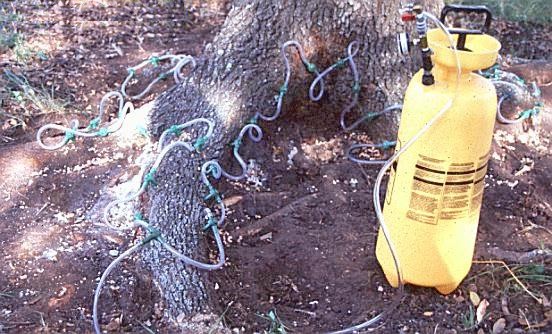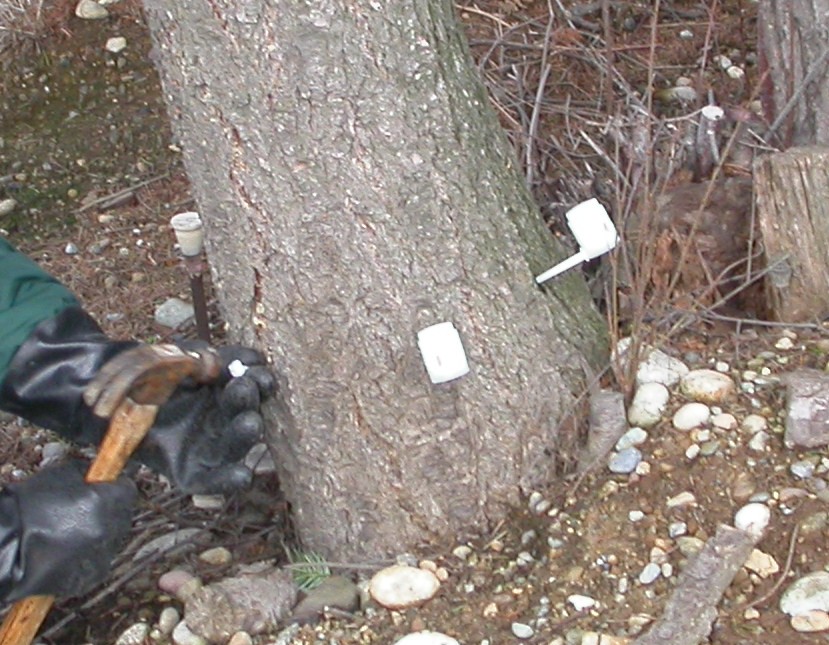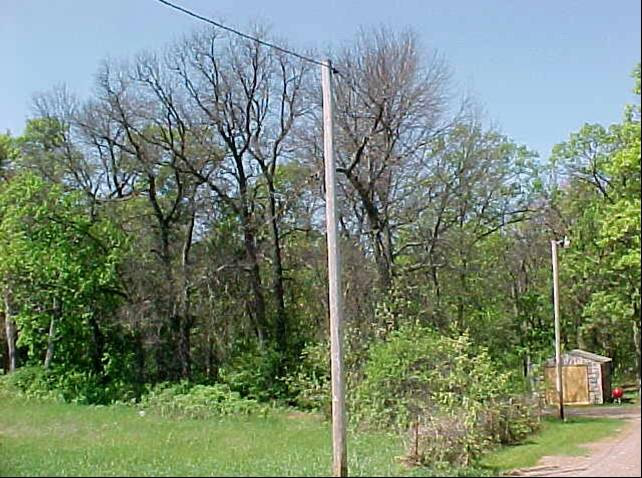Section 3: Oak Wilt
Anchor: #i1002371Background
Oak Wilt is caused by the fungus Ceratocystis fagacearum. The first confirmed case of Oak Wilt was in Wisconsin in the early 1940s. It was not confirmed in Texas until 1960. It is comparable to Dutch Elm Disease, a fungal infection that has destroyed entire elm populations in the Midwest and Northeast United States. Although all oak species can contact Oak Wilt, Red or Spanish Oak and Live Oak are the two most susceptible.
Oak Wilt should not be confused with Oak Decline. Decline is a catch-all term used when a tree under stress falls prey to any number of diseases or insects. Oak Wilt invades the water and food tissues of oak roots and limbs. It is a true wilt disease.
Anchor: #i1002386Affected Area
Oak Wilt has been found in more than 60 counties, mostly in the central part of the state.
Figure 4-8. Oak Wilt occurrences in Texas counties.
Anchor: #i1002405How it Spreads
The Oak Wilt fungus most often spreads underground from infected trees to adjacent healthy trees through interconnecting roots. Sap beetles also carry fungal spores from infected trees to open cuts or wounds on healthy trees. The fungus can also be spread by pruning tools. Since fungal mats only appear on diseased Red Oaks or Spanish Oaks these trees must be removed immediately and chipped, burned or buried. Firewood can be used from infected Live Oaks if the wood is seasoned and properly dried.
Figure 4-9. Live Oak roots from separate trees grafted together. This is the primary way that Oak Wilt spreads from tree-to-tree.
Figure 4-10. Sap Beetles (Nitidulid Beetles) spreading Oak Wilt Fungus. Secondary vector of Oak Wilt fungus.
Anchor: #i1002433Symptoms
Spanish or Red Oaks infected with the Oak Wilt fungus will often form fungal mats on the trunk area and often die within one to four weeks, while Live Oaks may die within a period ranging from one month to two years. Infected Live Oak trees show browning of the leaves on individual limbs. Also, leaves on infected limbs will show specific patterns of chlorosis or yellowing. Defoliation occurs quickly after symptoms are observed.
Figure 4-11. Veinal leaf necrosis of Live Oak leaves infected with the Oak Wilt fungus.
Figure 4-12. Veinal leaf necrosis of Red Oak leaves infested with the Oak Wilt fungus.
Anchor: #i1002461What Can Be Done?
There is no cure for Oak Wilt. Two fungicides have been developed that will control the disease if detected in the early stages. (Contact the Vegetation Management Section staff at (512) 416-3093 for information.)
Therefore, the following preventive measures offer the only means of control:
- Anchor: #CJJCCILG
- Perform necessary pruning and cutting of healthy trees during the winter months of January and February when Sap Beetles are least active. Anchor: #ESOIBHHU
- Treat wounds with pruning paint in Oak Wilt infected counties to discourage insects, especially during warm weather. Anchor: #FVGUXWWW
- Sterilize all pruning tools in either LysolTM spray or a 70 percent rubbing alcohol solution. The use of chlorine bleach solutions to sterilize pruning tools is discouraged due to premature oxidation or rusting of steel parts. Anchor: #BLPDKHOG
- Destroy the tree cuttings by burning or burying the wood.
Once Oak Wilt has been confirmed, steps can be taken to prevent spread, including:
- Anchor: #LXEFQIBX
- trenching around and removal of infected trees Anchor: #CRMFSPIQ
- injection of approved fungicide.
Be sure to get positive identification of the Oak Wilt fungus before taking these drastic actions.
Figure 4-13. Hose harness, injectors and pressurized application tank for Alamo fungicide.
Figure 4-14. Pressurized injectors of Mauget Tebuject fungicide for Oak Wilt suppression.
Figure 4-15. Oak wilt infested trees dying in a circular pattern.
Figure 4-16. Oak Wilt infested trees dying.
More Information
More information on Oak Wilt may be obtained from the following sources:
- Anchor: #VMXAAVVE
- Maintenance Division, Vegetation Management Section (512) 416-3093 Anchor: #PSURCDKY
- Texas Forest Service Anchor: #GATNMJSP
- Texas Agricultural Extension Service.
